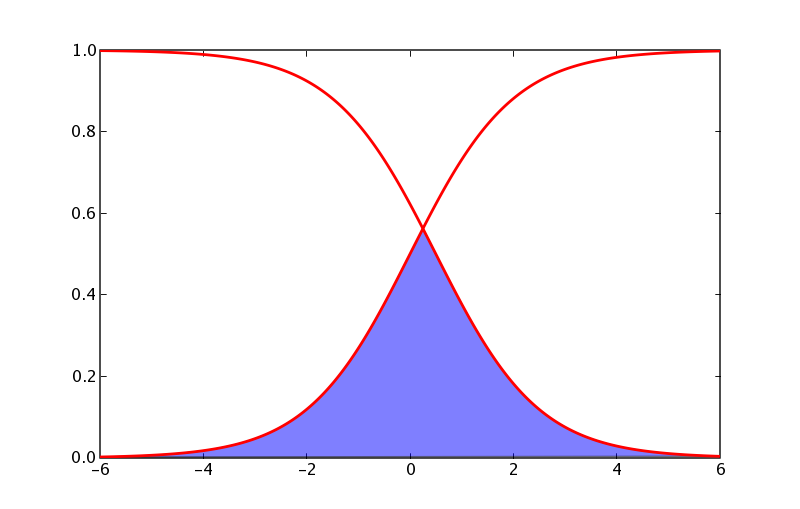Matplotlib:S 型函数¶
| 日期 | 2006-02-09(最后修改),2006-01-22(创建) |
|---|
matplotlib 绘制函数的方法要求您计算要绘制的曲线的 x 和 y 顶点,然后将其传递给 plot。例如,对于正态 PDF,matplotlib.mlab 提供了这样的函数
In [ ]
from matplotlib.mlab import normpdf
import matplotlib.numerix as nx
import pylab as p
x = nx.arange(-4, 4, 0.01)
y = normpdf(x, 0, 1) # unit normal
p.plot(x,y, color='red', lw=2)
p.show()
In [ ]
import matplotlib.numerix as nx
import pylab as p
def boltzman(x, xmid, tau):
"""
evaluate the boltzman function with midpoint xmid and time constant tau
over x
"""
return 1. / (1. + nx.exp(-(x-xmid)/tau))
x = nx.arange(-6, 6, .01)
S = boltzman(x, 0, 1)
Z = 1-boltzman(x, 0.5, 1)
p.plot(x, S, x, Z, color='red', lw=2)
p.show()
另请参见 mathworld 上的 sigmoid。
人们通常希望对这些曲线下的区域进行阴影处理,例如 它们交点的下方,您可以使用 numerix 和 matplotlib 的 [http://matplotlib.sourceforge.net/matplotlib.pylab.html#-fill fill] 函数来实现。
In [ ]
import matplotlib.numerix as nx
import pylab as p
def boltzman(x, xmid, tau):
"""
evaluate the boltzman function with midpoint xmid and time constant tau
over x
"""
return 1. / (1. + nx.exp(-(x-xmid)/tau))
def fill_below_intersection(x, S, Z):
"""
fill the region below the intersection of S and Z
"""
#find the intersection point
ind = nx.nonzero( nx.absolute(S-Z)==min(nx.absolute(S-Z)))[0]
# compute a new curve which we will fill below
Y = nx.zeros(S.shape, typecode=nx.Float)
Y[:ind] = S[:ind] # Y is S up to the intersection
Y[ind:] = Z[ind:] # and Z beyond it
p.fill(x, Y, facecolor='blue', alpha=0.5)
x = nx.arange(-6, 6, .01)
S = boltzman(x, 0, 1)
Z = 1-boltzman(x, 0.5, 1)
p.plot(x, S, x, Z, color='red', lw=2)
fill_below_intersection(x, S, Z)
p.show()
正如这些示例所示,matplotlib 没有提供用于绘制人们想要绘制的所有类型曲线的辅助函数,但它与 numerix 和 python 一起提供了构建这些函数的基本工具。

章节作者:AndrewStraw,RobManagan
附件